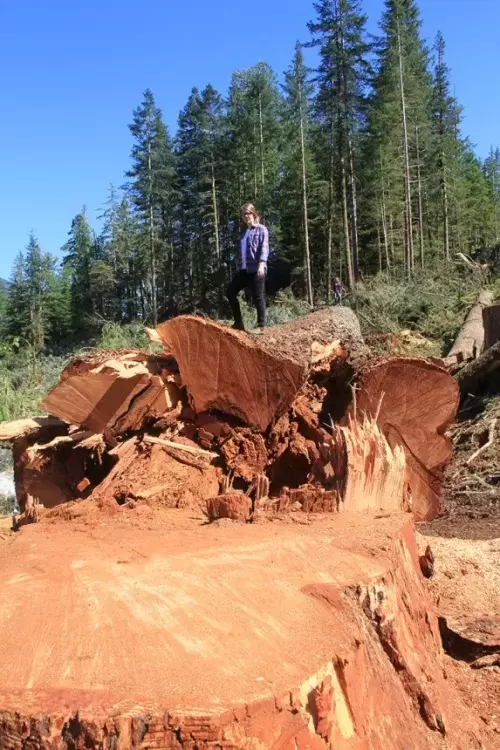With some of the largest trees in Canada on the chopping block in the Nahmint Valley, the provincial government is negotiating an agreement with the Tseshaht First Nation to better manage the forest land.
News of the old-growth logging broke in May, when the Ancient Forest Alliance publicized harvesting practices that included cutting down a Douglas fir measuring 10 feet in diametre and 31 feet in circumference. These dimensions rank the Douglas fir among the top 10 largest of its species in the country, according to the BC Big Tree registry, a public record managed by the University of British Columbia. The Nahmint Valley also contains a 14-foot-wide western red cedar and the Alberni Giant, a Douglas fir measuring 12 feet in diameter. Both of these trees, which are still standing, are wider than the largest in mid-Vancouver Island’s Cathedral Grove, a Douglas fir which is more than 800 years old.
The Nahmint Valley is within the Tseshaht’s unceded traditional territory, but from November 2017 to March 2018 five timber sale licences in the area were auctioned by BC Timber Sales without the First Nation’s consent, sand Chief Councillor Cynthia Dick. BC Timber Sales is a provincial agency that manages Crown forest land.
“We have expressed the need for a cedar management strategy in Tsesaht territory as well as the need for a shared decision-making framework,” said Dick in an email to the Ha-Shilth-Sa.
“The Ministry of Indigenous Relations and Reconciliation is currently in early discussions with the Tseshaht First Nation to negotiate a broad reconciliation agreement, and timber sales is one of a number of elements on the table as part of these discussions,” stated the provincial ministry. “We recognize this issue in the Nahmint Valley is of particular and grave concern to the Tseshaht people. We feel that this issue would be best addressed at the negotiation table.”
Dick cited a pledge made by Premier John Horgan to follow the United Nations Declaration on the Rights of Indigenous Peoples and the Tsilhqot’in court decision. In the 2014 the Supreme Court of Canada ruled that a province cannot claim a right to clear cut forest within a First Nation’s traditional territory where it holds Aboriginal title.
B.C.’s Ministry of Forests, Lands, Natural Resource Operations and Rural Development stated that concerns about the old-growth logging are being addressed according to 10 principles the provincial government enacted in May to “provide high-level guidance on how provincial representatives engage with Indigenous Peoples.” These principles include recognizing that “meaningful engagement with Indigenous peoples aims to secure their free, prior and informed consent when B.C. proposes to take actions which impact them and their rights, including their lands, territories and resources.”
“This work will take time and require changes to the way things have been done,” stated the Ministry of Forests. “Our government is committed to a new relationship with First Nations and Indigenous peoples.”
This is not the first time logging practices in the Nahmint Valley have sparked concern. In 2014 a group from the Tseshaht set up a blockade to logging trucks after the province failed to work out a cedar management plan with the First Nation.
The logging of Nahmint’s old growth has continued in recent years, and since August 2016 BC Timber Sales has sold 319 hectares for forest land in the valley. The Vancouver Island Land Use Plan, a provincial stewardship document, categorizes the Nahmint area under “special management” which prioritizes “environmental, recreational and cultural heritage values,” leaving some to wonder why so much of the valley’s old growth is still being logged. There remains 2,760 hectares of old growth in the area that will never be cut, according to the Ministry of Forests.
In a document titled “Best Management Practices for Coastal Legacy Trees” dated Sept. 11, 2017, BCTS laid out guidelines to protect some of the trees that are currently being cut in the Nahmint Valley.
“BC Timber Sales recognizes that legacy trees are often attributed with having important cultural, aesthetic and ecological value,” stated the document. “These trees, when retained, can play an important role in habitat conservation by bridging old-growth characteristics into second-growth stands. In addition, large trees are increasingly supporting the growing ecotourism economy as valuable destinations in and of themselves.”
But the guidelines also state that not all legacy trees can be protected due to safety hazards or the “local abundance of legacy trees.”







